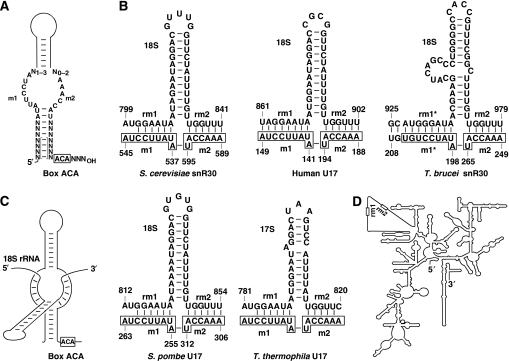Figure 3.
A proposed interaction of snR30/U17 with 18S rRNA. (A) A consensus structure for the 3′-terminal hairpins of snR30/U17 snoRNAs. The conserved m1, m2 and box ACA sequences are shown. The bracketed base-pairing interactions are not conserved. (B) Putative base-pairing interactions of snR30/U17 snoRNAs with cognate 18S/17S rRNAs. The m1 and m2 motifs selecting ribosomal rm1 and rm2 sequences are boxed. For sequences of human, S. cerevisiae, S. pombe and T. thermophila snR30/U17 snoRNAs, see Atzorn et al (2004) and references therein. T. brucei snR30 has been reported by Barth et al (2005). Sequences of human (U13369), S. cerevisiae (J01353), S. pombe (X58056), T. thermophila (M10938) and T. brucei (AJ009142) 18S/17S rRNAs are from the GenBank. (C) A schematic representation of the predicted interaction of the 3′-hairpin of snR30/U17 snoRNAs with 18S/17S rRNA sequences. (D) A schematic two-dimensional structure of yeast 18S rRNA. A central domain of 18S that is missing from E. coli 16S rRNA is unfolded (Gutell, 1993). Positions of the rm1 and rm2 sequences are indicated.

